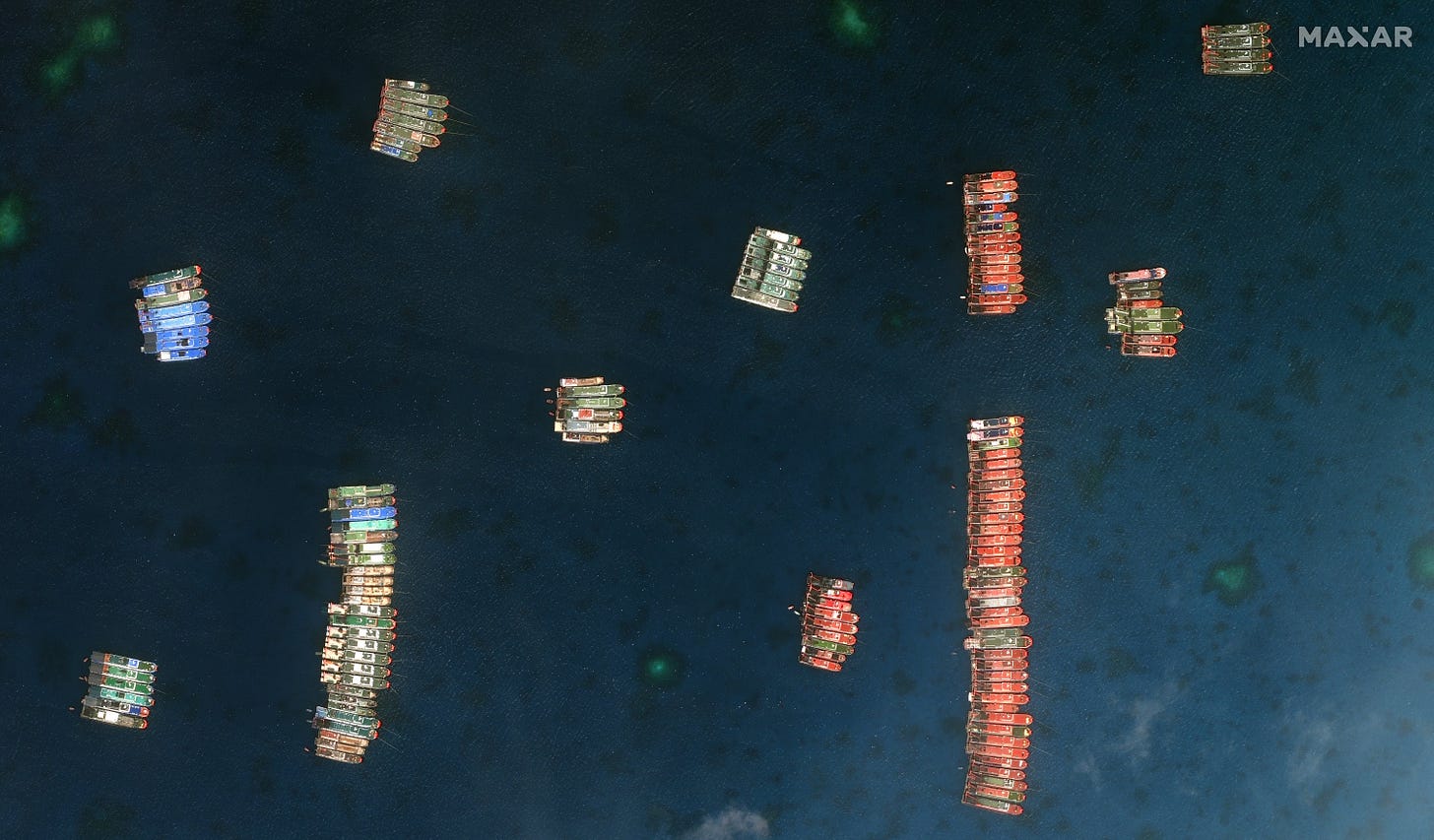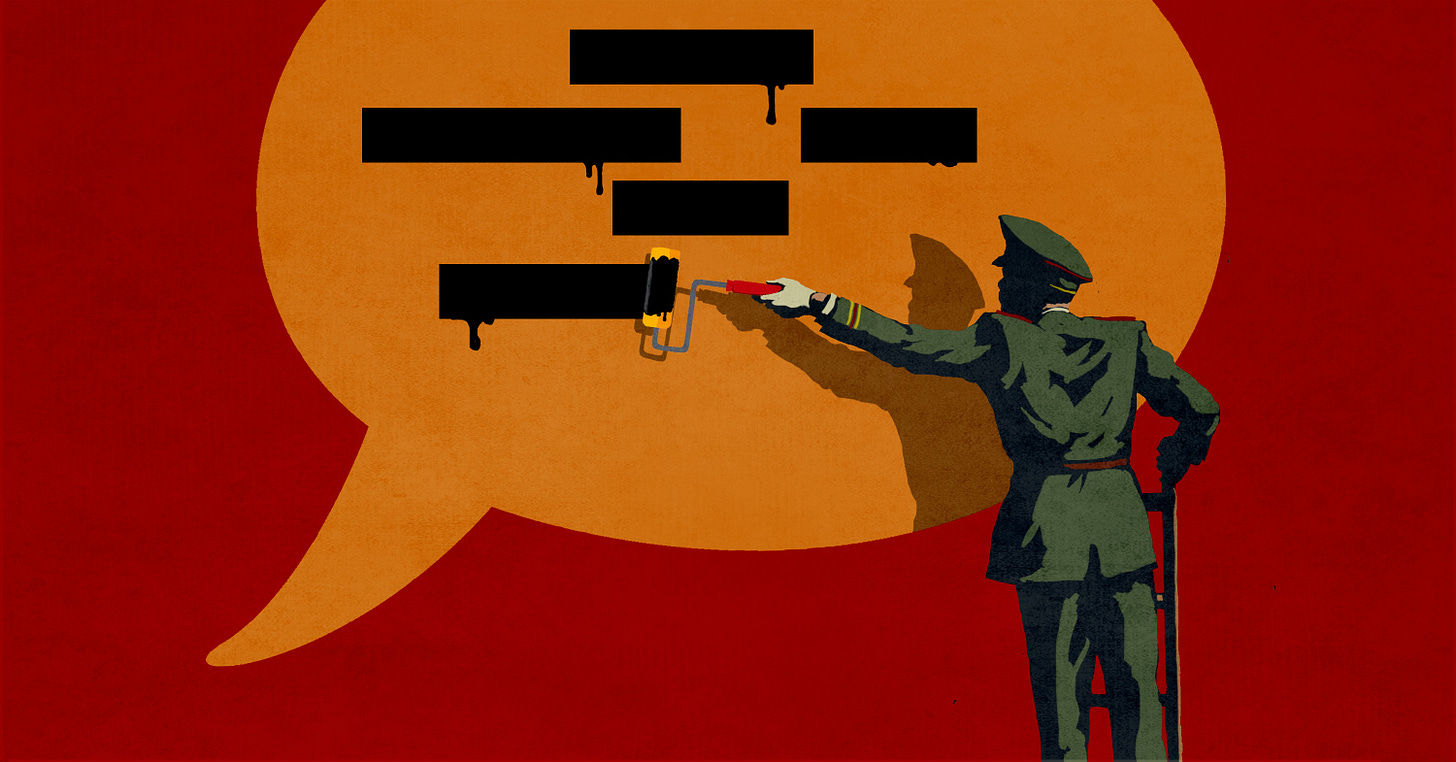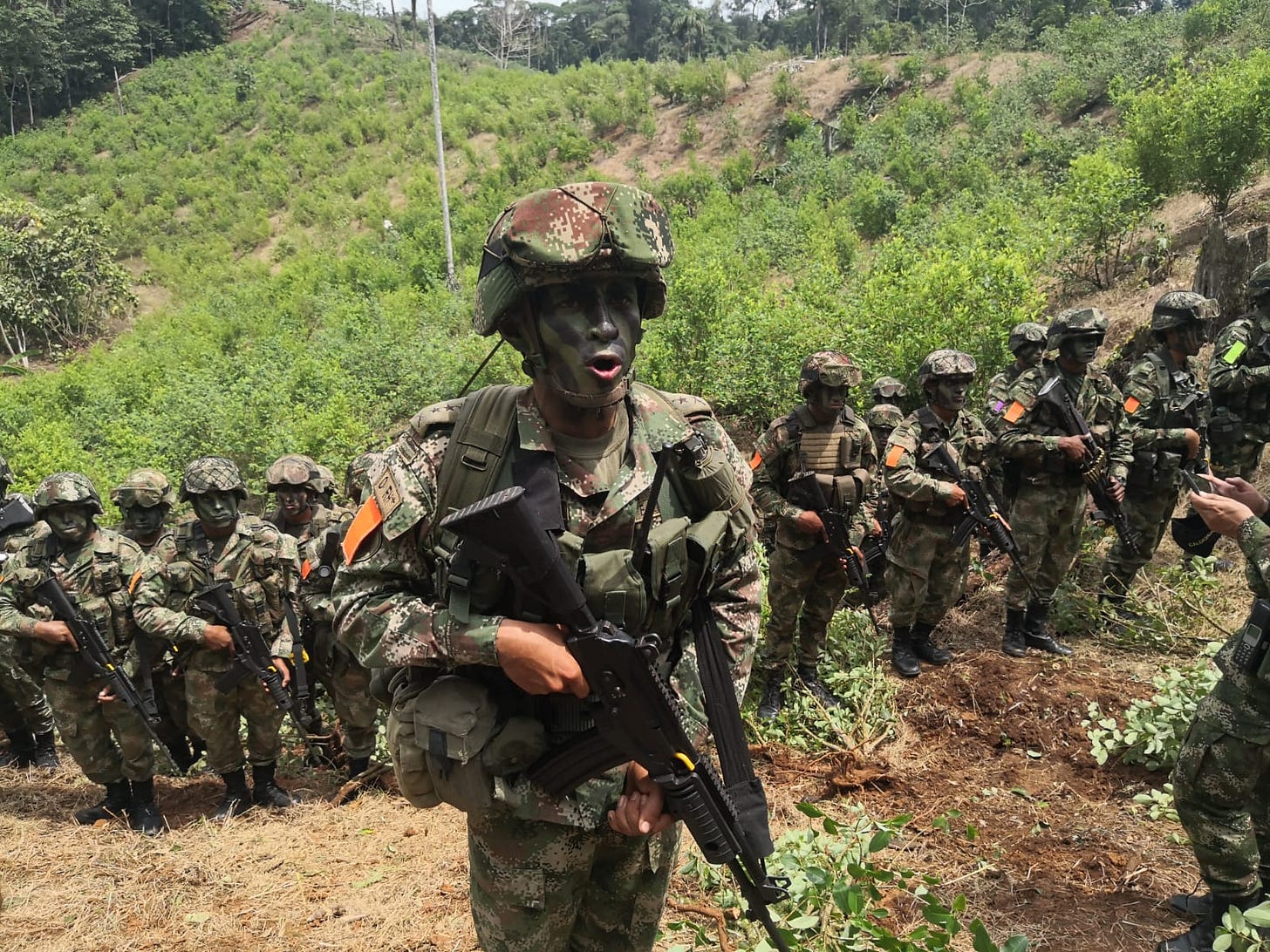Hey Team,
Another week, another SITREP. Key themes coming out of the Indo-Pac over the previous 7 days:
China’s economy is seeing a pretty significant contraction which is likely to further impact regional financial markets with effects being felt at the consumer level,
Taiwan fears China may invade by 2027, and
the United States weighs in and reminds China of the ‘red line’ over Ukraine.
For those with access to the Compartmented Information (at the bottom of this SITREP), I’ve extracted more captured Russian military documents from Ukraine for your perusal.
Enjoy.
Cole // ALCON.S2
POLITICAL
Philippines President Expresses his Concern Over South China Sea
The President of the Philippines, Ferdinand Marcos Jr., has expressed deep concern over the escalating tensions in the South China Sea. Speaking at the World Economic Forum in Davos, Switzerland, Marcos emphasized the importance of peace in the region and the Philippines' commitment to it, despite Beijing's territorial claims. He stated that the issue of the South China Sea was an important and unavoidable one that required attention, not only for diplomatic and security reasons, but for the livelihood of Philippine citizens as well.
Furthermore, Marcos emphasized that the future of the region should be decided by the region itself, and not by outside forces. He noted that there is a unanimity of belief among the leaders of ASEAN that the region must be committed to ASEAN Centrality, which essentially means that the future of the region must be decided by the region. He also highlighted that increased tensions in the region have an effect on trade, not just for the Philippines but also for other countries within ASEAN, China, the United States and other countries in the region.
United States Warns China of Red Line
The United States is warning China against providing material and security assistance to Russia in Moscow’s war on Ukraine, laying out Washington’s red line ahead of U.S. Secretary of State Antony Blinken’s visit to Beijing early next month. This week’s military-to-military talks come as the U.S. is monitoring closely any decisions by the People’s Republic of China (PRC) in response to Russian requests for security assistance. The U.S. official took note of reports about multiple visits to China by Russian transport aircraft.
“I don’t have a new assessment to offer,” State Department spokesperson Ned Price told VOA last week when asked if it is still Washington’s assessment that Beijing is not providing security assistance to Russia. “If we see the PRC taking action to systemically assist Russia evade sanctions, of course there will be costs,” said Price. Tuesday’s two-hour talks came after China turned down a U.S. offer for military de-confliction talks between U.S. Defense Secretary Lloyd Austin and Chinese Defense Minister Wei Fenghe earlier this month.
MILITARY
China More Likely to Invade in 2027, Faces Threats from ‘ External Forces’
In an interview, Joseph Wu, Taiwan's foreign minister, stated that Taiwan may take steps towards official independence by 2027, due to increasing tensions with China. Wu also acknowledged that the current "status quo" of Taiwan being self-governing but not officially declaring independence may not last forever, and the island could potentially be assimilated by China or become an independent country. Taiwan is currently a democratic, self-governing island but is considered by China as part of its territory.
He warned that Taiwan may face pressure from China to be brought under Chinese control by 2027. He stated that President Xi Jinping views Taiwan as at the "core of China's core interests" and that in 2027, Xi Jinping is likely to be in his fourth term, and if he cannot claim any achievement during his previous terms, he might resort to using force or creating a crisis in Taiwan to divert domestic attention or to show the Chinese that he has accomplished something. Wu also acknowledged that the situation in Taiwan has worsened in the last year compared to the previous years, and Taiwan is concerned that it might become a scapegoat for the current issues in China such as the declining economy and dissatisfaction among the citizens.
Seperately, a former Chinese spy chief has warned that China is facing increasing threats from "external forces" that could lead to food shortages and financial instability. He urged China to prepare for potential escalation of "bullying by the hegemonies" and called for action against "malicious practices" such as blackmail, containment, and blockades, which he believes may escalate at any time. He also warned that global energy, food, and financial crises may pose a threat to China's national security and social stability.
China has Become India’s Biggest Threat
India is facing a growing threat from China that poses a severe risk to the country's national security and stability. This is reflected in a recent Morning Consult poll that revealed that Indians see China as India's "greatest military threat." 43% of respondents named China as their top threat, while only 13% cited Pakistan, India's long-standing rival. The shift in Indian perspectives on the country's long-term strategic challenges is a clear indication that New Delhi's focus has shifted towards Beijing.
The threat from China is multifaceted and includes challenges on several fronts. India has struggled to deter Beijing on their shared border, with Chinese troops continuing to make incursions into India, including one last month. Furthermore, China is expanding its naval presence in the Indian Ocean, causing grave concern for India. The country also worries about Chinese surveillance, leading to the ban of more than 300 Chinese mobile apps, citing security concerns.
The shift in India's threat calculations towards China highlights the need for India to deepen its partnership with the United States and its Asian treaty allies. However, India must also maintain a balancing act with Moscow, which has grown closer to Beijing amid the war in Ukraine. India's foreign policy has turned towards China in recent years, with efforts to counter China such as the Quadrilateral Security Dialogue and the Indo-Pacific Economic Framework. The country is all-in on strengthening security relations with the other three Quad members: Australia, Japan, and the United States. The growing threat from China requires India to be vigilant and take all necessary measures to protect its national security.
ECONOMIC
China’s Economy Slumps to Worst Levels in Nearly 50 years
China's economy in 2022 has faced significant challenges due to strict COVID-19 restrictions and a slump in the property market. These factors have led to one of the worst levels of economic growth in nearly half a century and have increased pressure on policymakers to implement further stimulus measures.
Despite this, some indicators such as retail sales have exceeded market expectations. However, analysts have pointed out that the overall economic impulse in China remains weak and that there are significant challenges facing Beijing as it deals with the aftermath of lifting its "zero-COVID" policy. The GDP growth of 2.9% in the fourth quarter, while slower than the previous quarter's 3.9%, is still higher than the second quarter's 0.4% and above market expectations of 1.8%. This suggests that while the economy is facing challenges, it is not necessarily in a dire state.
Furthermore, foreign investors reduced their exposure to China's domestic bond market in 2022, becoming net sellers for the first time in a decade. They cut their holdings of yuan-denominated bonds by $91 billion, which is the only annual net outflow since China's central bank began publishing foreign ownership figures in 2013. This decrease in foreign holdings brought the total to $500 billion, a decrease from $591 billion at the end of 2021.
Economic Indicators as at 20 JAN 22
Japan's stock market index is up by 1.23%. November Tertiary Industry Activity Index falls 0.2% m/m.
Bank of Japan kicked off its two-day monetary policy meeting. The yield on Japan’s 10-year treasury continues to test the upper ceiling of the central bank’s tolerance range.
China's stock market index is down by 0.14%. GDP growth in 2022 was 3%, however, analysts believe it is much lower. Q4 GDP 0.0% q/q (expected -0.8).
China's retail sales beat estimates and the economy expands more than expected.
Hong Kong's stock market index is down by 1.01%.
Australia's stock market index is down by 0.03%. Weekly consumer confidence survey rose, still deeply pessimistic at 87.7. Monthly consumer confidence data +5% to 84.3.
India's stock market index is up by 0.64%.
New Zealand business confidence fell even more in Q4: -70% vs. -42% prior.
Singapore's stock market index is down by 3.3% m/m. Non-oil domestic exports fell 20.6% in December on an annualized basis, a further drop from a decline of 14.7% seen in November.
Oil prices are mixed on Tuesday after China posted its weakest economic growth in nearly half a century. Brent crude futures rose 16 cents, or 0.2%, to $84.62 by 0414 GMT. U.S. West Texas Intermediate (WTI) crude futures slid 60 cents, or 0.8%, to $79.26 from Friday’s close.
Gold prices inched lower on Tuesday, weighed by an uptick in the dollar, although hopes of slower interest rate hikes by the Federal Reserve capped further losses.
U.S. stock market indexes are lower: Dow Jones -0.07%, S&P 500 -0.10%, Nasdaq -0.12%.
SOCIAL
China Announces Censorship Measures for Lunar New Year to Combat Covid-19 Related "Rumors"
The Chinese government has announced a harsh crackdown on internet censorship during the lunar new year festival in order to prevent the spread of "gloomy sentiments" caused by what they deem as "rumours" about the ongoing Covid-19 pandemic. This move comes as health forecasting firm Airfinity estimates that more than 600,000 people have likely died since zero-Covid restrictions were lifted in December, a staggering 10 times more than what Chinese authorities have officially declared.
The "Spring Festival online improvement" program, which will last for a month, aims to target those spreading information about the spread of Covid-19 and patient experiences that do not align with the official narrative. The national cyber administration has specified that the program will involve "in-depth rectification of false information and other issues to prevent gloomy sentiments." This includes the investigation and punishment of those spreading "online rumours related to the epidemic," "fabricating patient experiences," and producing or sharing fake virus treatments. The government claims that this move is to "prevent misleading the public and causing social panic."
INFORMATION
The Future of Cyber in the Indo-Pacific
The geostrategic competition between the US and China will have a significant impact on the future of cyber warfare in the Indo-Pacific region. However, there are specific developments that will shape how offensive cyber tools and tactics are used.
The digital transformation of economies and societies in the region is creating a new balance of power and influence. Countries like Singapore, Japan, and South Korea are leading digital economies, India is a software development powerhouse, China is a global provider of accessible technology and manufacturing resources, and many Southeast Asian countries have adopted ambitious digital economy strategies. This trend will continue, with digital trade accounting for a growing percentage of countries' GDP.
Governments in the region are implementing reflexive and restrictive regulatory approaches in cybersecurity, technology, and online information environments. Social media platforms, combined with the power of smartphones, are seen as a threat to stability by some states and to regime survival or social cohesion by others. Despite the diversity in political regimes, levels of prosperity, and approaches to internet governance and regulation, governments in the region are imposing sovereign borders on the different layers of the cyber domain.
The formation of new cyber defense forces has led to a new era of discussions about conflicts in the Indo-Pacific's cyberspace. Earlier cyber units have secured a central place in their countries' national security posture and the newer cyber defense forces have growing mandates and influence. The extent to which appropriate checks and balances are established in the context of civilian oversight and control of cybersecurity agencies will be a key determinant of a state's future cyber behavior.
It is crucial to recognize that all three trends can be managed constructively and should be a concern for all stakeholders in the Indo-Pacific. Security in the region will remain competitive, with suppressed inter-state conflicts and contested national ICT domains. Internet governance communities must find a balance between promoting digital innovation, ensuring adequate cybersecurity, fostering a permissive online information environment, and ensuring a responsible role for security and intelligence services.
INFRASTRUCTURE
NSTR
FROM THE OUTSTATIONS
Global Analysis from the Online Intelligence Community.
Clan De Golfo Issues Pamphlets to Environmental Activists and Residents Stating They Are Now Military Targets - Expint.v1
For the past 10 days, residents, and environmentalists have been staging peaceful protests throughout the Oponcito region in Columbia advocating the local and national government to revoke the recent license granted to COLCCO allowing the company to expand its open-pit coal exploitation practices. The protests have consisted of mainly of sit-ins and blockage of public roadways in the region. Due to this, two pamphlets have been circulated to the demonstrators by the AGC expressing that the protests must stop as they have caused major breakdowns in infrastructure flow resulting in an economic slowdown in the affected areas.
Despite the messages from the armed group, protests have ensued prompting a third pamphlet to be issued which was confirmed today. In today’s pamphlet, the armed group declared the protests as a military objective and stated that 19 perceived leaders of the protests are now military targets. While the statement did not detail the exact ramifications of the targeting, many recipients fear that the AGC will begin taking violent action against peaceful demonstrators. Due to the circulation of the pamphlets from the armed group, local authorities requested the protection of Colombia’s national defense forces (UNP) to shield the rights of those who protest.
The AGC, A.K.A Clan de Golfo, is one of Colombia’s largest and most powerful paramilitary organizations and is estimated to control most of the country’s drug trade. Authorities formally consider the AGC a “Class A Organized Armed Group” and claim the group is the main ally of the Sinaloa Cartel from Mexico. The AGC was birthed in 2008 following the dismantlement of the infamous AUC headed by the Castano brothers who were known to be used as proxies by infamous Colombian cartels to carry out violent attacks against the state and their competitors. Following their creation, the AGC quickly took control of the former organization’s criminal activities while expanding operations as far as the Venezuelan border. As of recently, it is estimated that the AGC has over 8000 members, who are armed with large amounts of small arms, artillery, explosives, and armored vehicles.
US Navy Needs Smaller Ships - Vermilion China
The US Navy is facing a crisis of high volume enemy missile fire. WWI presented a similar dilemma to ground forces. The accuracy and volume of artillery fire increased significantly during the Great War. Military commanders only adapted after sustaining massive and demographic-altering losses. The solutions to powerful enemy fires are time-tested: dispersal of individuals and units, hardening of positions and equipment, combined arms surge attacks, intelligence support, built-in capacity to sustain casualties, decentralized leadership, and counter-battery fires.
While there are many solutions, the current naval philosophy relies heavily on dispersal or “distributed maritime operations.” Are they dispersed enough? Concentrating naval capability into fewer and larger vessels makes each vessel far easier to target and destroy with missiles. Day-in and day-out, the Navy operates its fewer and larger vessels by consolidating them into clusters with complementary capabilities (air strike, amphibious, or surface action). While it is acknowledged that commanders are moving away from this concept, the process of change is far too slow.
COMPARTMENTED INFORMATION
Compartmented Information is exclusively sourced OSINT for those with a need-to-know. You will not find the following reporting anywhere else. Subscribe for access. In this weeks reporting:
Unidentified Russian Radar Computer Photos
Captured Battlefield Document: Duties of a Russian Army Platoon Commander
Captured Battlefield Document: Leadership Style and Relationship Between Commander and Subordinate in the Russian Military
Keep reading with a 7-day free trial
Subscribe to The Grey Zone to keep reading this post and get 7 days of free access to the full post archives.














